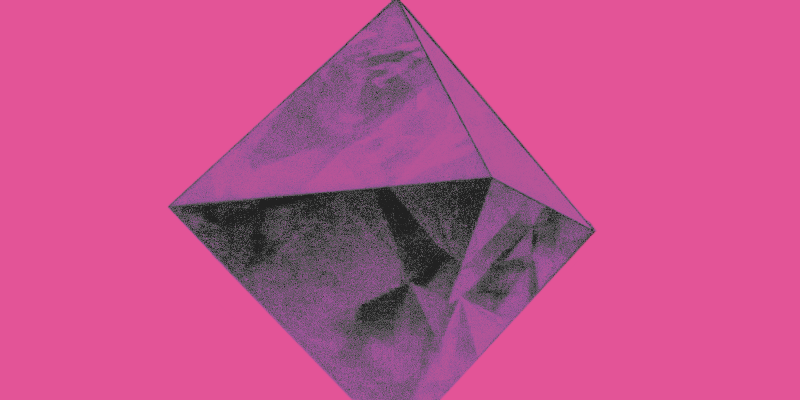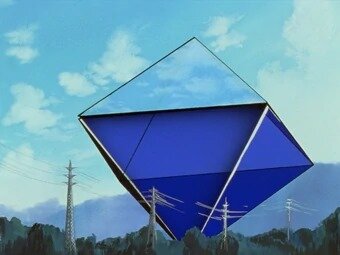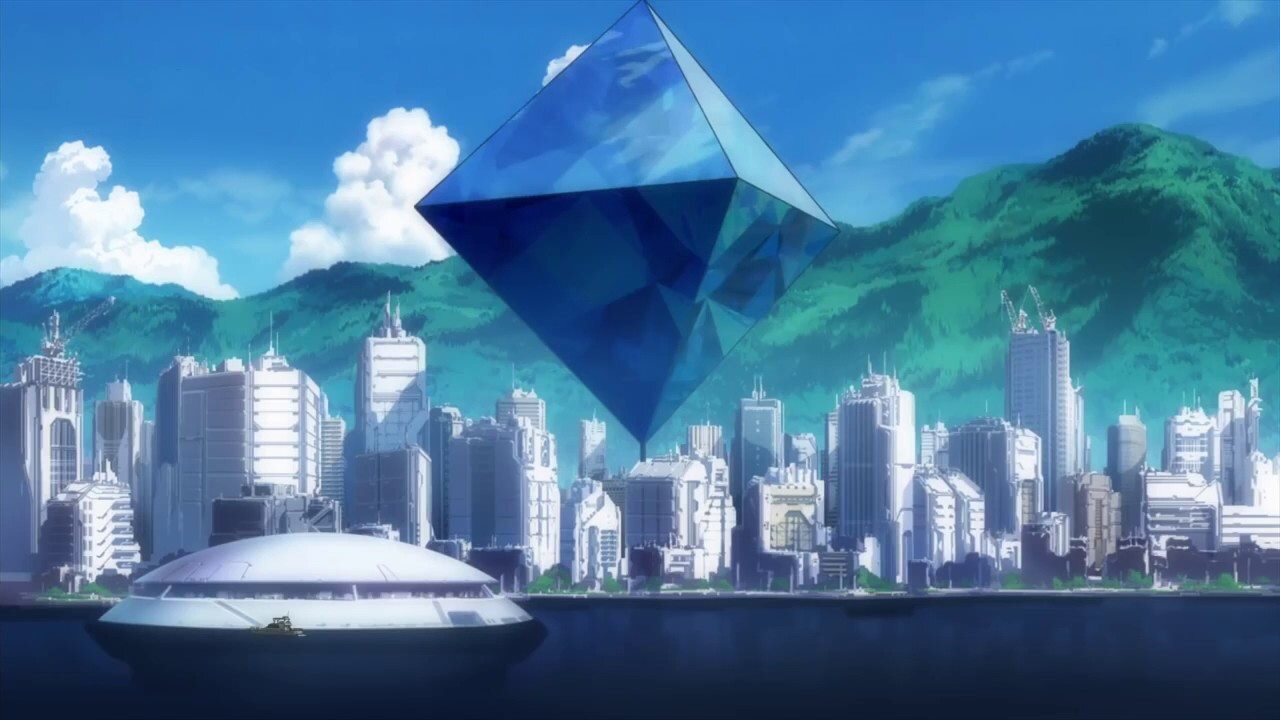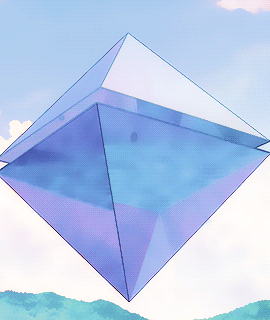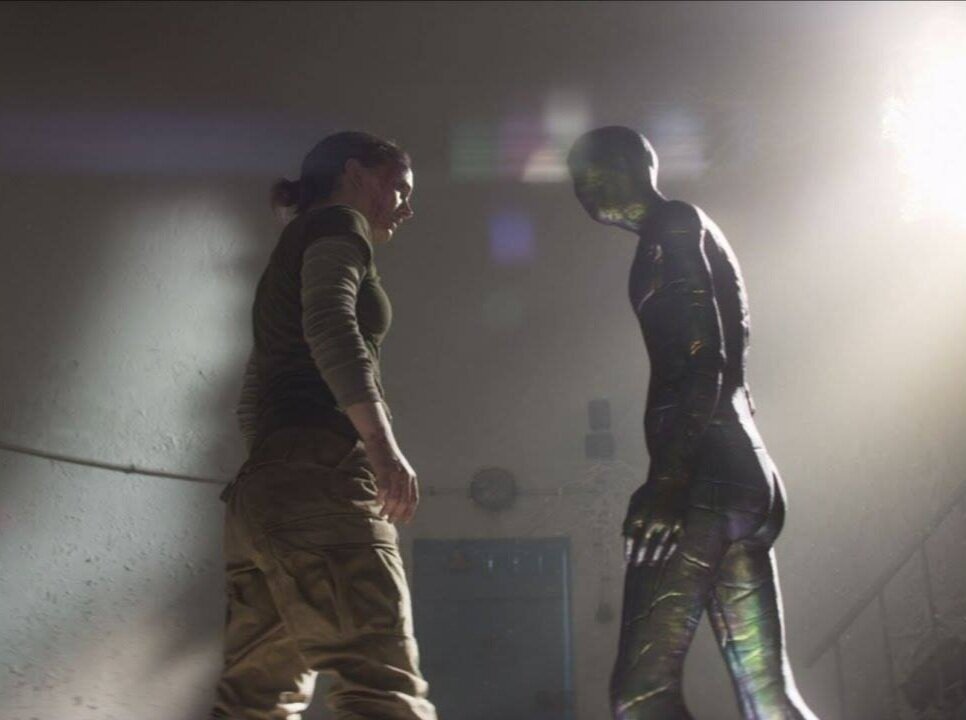12 Days of Monsters: Day 6
12 Days of Monsters is a series exploring the visual design of different monsters - looking at what makes them successful (or not), what trends they represent, and what they mean to me personally.
The Monster
Ramiel
from the 2007 film EVANGELION 1.0: YOU ARE (NOT) ALONE
History Lesson
On Reboots and Continuity
NEON GENESIS EVANGELION was an enormously successful and influential anime that originally aired starting in 1995, written and directed by Hideaki Anno (who you might recognize from my earlier post). It lasted for 26 episodes, with the finale airing in 1996.
In 2007, it was announced that Evangelion would be getting re-launched, this time as a series of 4 feature-length movies that would strive to retell the essence of the story from the original series. The project, called a "rebuild" instead of a "reboot", was also set to be written and directed by Hideaki Anno. The first of these movies, EVANGELION 1.0: YOU ARE (NOT) ALONE aired later in 2007.
YOU ARE (NOT) ALONE retells the events of the first 6 episodes of the original animated series. Most of the runtime is remastered footage from the original series, with plenty of touch-ups here and there, and some revisions to the story and pacing.
The monster I'm going to talk about appears in both the original series and in the rebuild. I'll be talking about it in both contexts - but since the rebuild makes some truly wonderful updates to its design, I'll be focusing a lot on the rebuild version. So let's jump in.
The Set-up
What are angels?
In Evangelion, humanity is attacked by immensely powerful otherworldly beings that are known only as "angels". (In addition to being called angels, the individual creatures are named after angels in apocryphal Abrahamic texts.) These are city-destroying monsters that are largely impervious to conventional warfare; in order to beat them, humanity resorts to giant biomechanical machines called Evangelions (or "Evas" for short), which can only be piloted by special children.
The angels appear one-at-a-time, and appear to be attempting to reach a hidden place underneath Tokyo-3 - and we're told that if they reach it, the world will end.
The first angel we see (Sachiel) is, functionally, just Godzilla. It's a gigantic green monster that shrugs off heavy artillery and missiles, fires devastating energy-based attacks, and is resilient enough to survive a direct hit from a nuclear bomb. It is eventually killed when the Eva piloted by the show's protagonist (Shinji) beats it to a bloody pulp with its bare hands.
The next angel we see (Shamshel) is similar, but with some upgrades. It's basically a building-sized brawler too, like Sachiel before it, but instead of arms or claws, it has two lightsaber tentacles that can slice through buildings like paper. This angel also gets beaten by Shinji, though it's a lot tougher - Shamshel and Shinji's Eva end up stabbing each other at the same time, and the angel dies before the Eva does.
The third angel we see...that's the one I want to talk about here.
The Visual Design
Screaming Geometrically
Ramiel as it appears in the original 1995 anime
The next angel (Ramiel) takes us in a very different direction. While I loved the design of the previous two angels, and I love the design of many more angels that would come later in the series, I had to pick this one to feature as it's such a clear inflection point in the design of these creatures - and thus, a clear sign to the viewer that there's more going on with this show than you thought at first.
Because this angel just looks like a simple cuboid prism. Literally a big glass box.
Sure, it's very big, but that's basically it. (As it appeared in the original anime, at least - in the rebuild, starts out that way, but...well, we'll get to that.)
This design is so unexpected that it immediately fixes your attention. You might not consciously realize it yet, but you know immediately that this angel won't go down in a fistfight, because the creature as designed can't even visually participate in a fistfight. And indeed, this angel has what you might uncharitably call a gimmick: whenever anything threatening gets within a certain (very wide) radius of the angel, it immediately fires a preposterously powerful laser beam at it - one that's capable of punching holes in skyscrapers like they're screen doors, and even melting the sides off mountains. It does this instantaneously, faster than any human can react - and so, our Evas can't even get close to it. Shinji goes up to fight it, and is nearly incinerated before he even realizes what hit him.
This is a particular problem, because the angels are all protected by a sort of force-field that can normally only be pierced by an Eva. (I won't get into it, but it makes sense in the show, trust me.) So if an Eva can't get close to this angel...how can we even fight it?
The angel floats over to the spot directly above where it wants to dig up the end of the world, extrudes a little drill from its bottom, and just sits there. Drilling. Once it drills deep enough, the world ends. Humanity has until then to figure out how to beat this thing that they can't get anywhere near.
Ramiel is almost more of a puzzle than a monster.
This is a pretty hard turn away not just from the other angels we've fought so far, but from genre conventions for "big mechs punching big monsters" in general. Here, the extremely simple design of the creature serves double duty: As a sign that the show is going to be willing to get more abstract and out-there, and to signal that these creatures should be thought of as alien things above all else. After all, Ramiel is a being comprised entirely of right angles, a form that virtually doesn't exist in any other organism.
After the battle against Ramiel, the anime continued to deliver both more traditional brawls between giant robots and giant monsters, and more truly out-there angel designs - like an enormous stylized eye-hand-leaf that falls from space, a glowing double-helix halo, and a living pocket dimension that's hidden in the shadow of a floating orb that doesn't really exist (kinda). Both categories of angel - the monstrous and the abstract - have some home run battles, and I could've picked many of them to feature here. But I picked Ramiel, because it showed up first, it signaled this creative tendency unmistakably loudly...
...and because in the rebuild, it gets even crazier.
Ramiel is the climactic battle of YOU ARE (NOT) ALONE. It has the same basic premise as its original appearance (automatic laser defense system that stops you from getting near it), and at first it has the same basic look when it shows up (floating glass box).
Ramiel as it appears in the 2007 rebuild YOU ARE (NOT) ALONE
The big difference is that it becomes more expressive, and honestly, it's hard to describe it well in words. Each time the angel is about to use its laser weapon, the glass box shifts - it refracts and collapses into itself, like a self-folding origami sculpture. It remains symmetrical in one way or another, but its axes of symmetry change as it shifts. Sometimes these kaleidoscopic configurations seem to break into parts that aren't even physically touching anymore.
Ramiel’s cuboid form gives way to something stranger in the rebuild
It cycles through several of these configurations over the course of the encounter. This abstract, impossible, "what even is physics" way that it moves and changes forms highlights how weird and alien this being is - but it also makes it less alien, in a subtle way. It doesn't appear to shift at random, and eventually you notice that there are some configurations it seems to hold, or reverts to repeatedly. This gives you at least the opportunity for insight into its behavior - you can try to figure out which configurations are more passive, and which ones mean something big is about to come. You also see some configurations that you can't cleanly interpret one way or the other. The rebuild version of Ramiel essentially doubles down on this creature as some sort of alien intelligence with this distinctive design that is also, by the way, visually stunning.
Oh, and it screams like a person.
Shrieks, actually.
Each time it gets ready to fire a big laser blast in the rebuild, it emits an eerie, high-pitched, human-sounding shriek - held just long enough to be strange, and with a weird shifting quality that seems to start out quieter and end up not only louder but sped-up as well. If there were a line between "definitely human" and "definitely not", these shrieks would fall on the "definitely human" side - while still being so close to the line that you find yourself re-evaluating it just to be sure each time you hear it.
This "vocalization" is, of course, completely incongruous with the visual design of the angel, which only makes it stranger and more compelling. This is all amplified by the fact that the shriek sounds terrified, which doesn't really make sense on the surface - the shriek is heard when the angel is about to be extremely aggressive.
And finally, the bright red cherry on top is that, in the rebuild, when Ramiel is killed, it bleeds. It gushes blood, in fact. This may seem like a minor detail, but remember that kaleidoscopic shifting: this thing can't possibly contain a contiguous circulatory system or organs. Like the shriek, is an unusually human element that comes from a form that's about as inhuman as it gets.
I think the rebuild knocks this updated design out of the park. Coupled with a memorable new soundtrack, this climactic battle ends YOU ARE (NOT) ALONE on a very strong note.
When I was a kid, I found myself struggling to articulate to my parents why Evangelion was such a gripping fixation for me - my clumsy attempts to describe it made it sound like every other generic kids-getting-into-big-robots show out there, from GUNDAM WING to POWER RANGERS. But Evangelion was really its own thing. If I were still having that argument now, I'd ask pointed questions like "Do the Power Rangers ever have to try to figure out how to punch abstract geometry?", and "Does Godzilla ever fall into a sentient shadow-hole that violently probes his psyche to understand the nature of loneliness by representing itself as a child version of Godzilla itself?", and "When have you ever seen a piece of mainstream media that tried to depict Abrahamic angels as eldritch alien monsters?"
And then I'd win that argument, and my parents would buy me all the Eva model kits I'd ask for, and they wouldn’t take them away even if my grades on the next report card were bad again.
Reflections
Accidentally Dangerous
This is bigger than just Evangelion, too.
I wasn't sure I wanted to include Ramiel on this list originally, since it's so different from every other monster on this list (that I've thought of so far) - but in the end, that's exactly why I wanted to include it. Because Evangelion isn't the only media to pull this sort of trick. And while the "so abstract we can't even be sure if it's intelligent at all" monster isn't exactly a common trope, it is nonetheless an extremely compelling one when done well.
The 2018 film ANNIHILATION - itself an absolutely excellent piece of art - ends with a monster that is ultimately very similar in concept. As the heroes of that movie explore the mutated biome of the Florida panhandle called “the shimmer”, the main threats to their safety are clear and physical: a big gator, a person with a gun, a mutant bear. But in the film's climax, the final challenge is fundamentally abstract. Multiple people in this place chose to kill themselves as the resolution of internal, existential questions that were posed to them by the alien intelligence presumed to be at the heart of all the unnatural happenings around them.
Facing down the heart of the shimmer in the finale of ANNIHILATION
When we finally meet that “intelligence”, it is something so abstract we can hardly know if it has any actual intelligence until the very end. Its initial visual representation is conceptually similar to Ramiel's rebuild - a kaleidoscopically shifting mass of lights and colors. Eventually it coalesces into a reflective shape, which proceeds to continue to refine itself further and further until it becomes less of an abstract shape and more an exact copy of the surviving protagonist. Indeed, virtually the only actions it takes are attempts to copy the exact movements of the protagonist - which results in physical danger to the protagonist almost by accident (e.g. when she goes to open a door, and the copy of her tries to open the same door at the same time, ending up pressing itself against her). Even though this being is both metaphorically and physically dangerous to our hero, it is so almost by accident. It is unavoidably an obstacle that must be overcome, but it is also a challenge to be understood on a more abstract level.
It, like Ramiel, is almost more a puzzle than a monster.
The shimmer proves harder to understand than expected, even as it tries to mirror us exactly
And in that way, it reflects an interesting fact about the angels in Evangelion: that they may well mean us no harm. Indeed, in the original anime, many of them try genuinely to understand and communicate with us, even though those attempts invariably end up being traumatic and painful for the humans involved. Sure, these otherworldly creatures are trying to do something which will result in the end of the world, but in Evangelion that's a much more complicated proposition that it would appear on its surface. And regardless, they never attack first, and are never wanton or cruel. Even the most vicious-looking and violent of the angels only ever act when directly opposed by mankind.
It's this characterization of the monsters in Evangelion that I think echoes the characterization of dangerous unnatural forces like those in ANNIHILATION (notably, the 1997 film PRINCESS MONONOKE depicts the Forest Spirit - an embodiment of nature itself - this way). Even as "peaceful" as these beings' behavior ultimately is, they are still undeniably monstrous. Except instead of being monstrous by virtue of being scary to look at, filled with spikes and many-jawed mouths and extra eyes, they are monstrous because of the perhaps unintended consequences of their existence - and because of how utterly alien they are to us.


